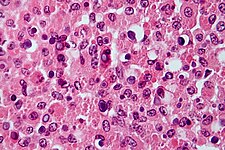Malakoplakia (from Greek Malako "soft" + Plako "plaque") is a rare inflammatory condition which makes its presence known as a papule, plaque or ulceration that usually affects the genitourinary tract.[1]:274 However, it may also be associated with other bodily organs. It was initially described in the early 20th century as soft yellowish plaques found on the mucosa of the urinary bladder. Microscopically it is characterized by the presence of foamy histiocytes (called von Hansemann cells) with basophilic inclusions called Michaelis–Gutmann bodies.
It usually involves gram-negative bacteria.[2]
| Malakoplakia | |
|---|---|
| Other names | Malacoplakia |
 | |
| Micrograph showing the characteristic finding of malakoplakia (Michaelis–Gutmann bodies). H&E stain. | |
Nocardiosis is an infectious disease affecting either the lungs (pulmonary nocardiosis) or the whole body (systemic nocardiosis). It is due to infection by a bacterium of the genus Nocardia, most commonly Nocardia asteroides or Nocardia brasiliensis.
It is most common in adult males, especially those with a weakened immune system. In patients with brain nocardia infection, mortality exceeds 80%; in other forms, mortality is 50%, even with appropriate therapy.[1]
It is one of several conditions that have been called "the great imitator".[2] Cutaneous nocardiosis commonly occurs in immunocompetent hosts.[3]
https://en.wikipedia.org/wiki/Nocardiosis
No comments:
Post a Comment